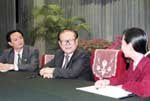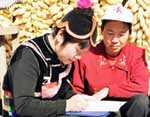 |
China Starts Counting World's Largest Population

China starts 5th National Census
|
The world's most populous country launched its fifth population census Wednesday, in a move to provide a base figure for mapping out a future development blueprint.
"The ongoing census is of great importance for China's economic and social development in the next five years or even a longer time range," said Wu Cangping, who was one of the first to study population science in China.
At zero hour Wednesday, more than 1,000 passengers, ID cards in hands, lined up quietly at the square of Beijing Railway Station,waiting for the turn to answer questions of the census takers.
The questions cover the name, age and residential address of the interviewees.

China Starts Fifth National Census
|
The census takers, with red certificates hanging from their necks, are part of the task force sent to public places, like railway and long-distance bus stations, to determine the floating population of people in and out of the city as well as the homeless.
A woman, who just stepped out a train carrying a sleeping baby in the arms, told a census taker the age and gender of her baby in front of media cameras.
Census information on migrants is considered the most difficult to collect. Beijing alone dispatched some 100,000 trained census workers, including policemen and statistics professionals, to count people with no permanent residence in Beijing.
Gao Baojun, a 72-year-old farmer from Gaojiacun Village of central China's Henan Province, said that the census takers asked more questions than they did last time.
China launched four population censuses since 1949 when New China was founded. The last one was carried out in 1990.
Gao came to Beijing for medical treatment. He was given a card afterwards to avoid being counted twice.
The census began to go in full swing after the sunrise, while census takers were knocking on the doors of over 300 million households across the country. Census worker Liu Tao visited Liang Jiaxiang, a farmer from Longshan Village on the outskirts of Beijing. He paid special attention to how many children Liang has.
As part of the census, a sample investigation is also carried out for more detailed information. One out of ten Chinese families will be chosen to answer 49 questions during the investigation,compared with some 20 questions for the rest families.
Some of the questions ask whether the family has bathing equipment and running water at home, and how much the family pays to buy or rent their residence.
These questions, listed for the first time in China's census questionnaire, are designed to see how much the Chinese people's living standard has improved over the past decade.
"Things are going the same way throughout the country," said Zhu Zhixin, deputy head of the leading group of the fifth population census under the State Council.
Six million census takers are supposed to visit every family in every city and village across the country in 10 days.
At Zhongnanhai, site of the central government, top Chinese leaders including Jiang Zemin, Li Peng and Zhu Rongji also received the census just like other citizens.
President Jiang hailed the census as being of great significance in drawing a clear picture about the quantity and structure of China's population for policy making.
The census is also carried out in recreation centers, temples,churches, prisons as well as on fishing boats. In Tibet, census takers will contact herds men on horseback out in the wilderness,where vehicles could not travel.
Sven Burmester, the United Nations Population Fund Representative in China, said that the way China conducts the census has been praised around the world. "I'm sure this time china can do it as well as it did 10 years ago."
China's population hit 1.1 billion a decade ago. The Chinese government started practicing the family planning policy in 1970s as a basic State policy, aiming to cap its population under 1.3billion by the end of this century.
Over the past decade China has redoubled its GDP and witnessed great changes in its economic and social structures, and the population as well.
The census also drew many foreign journalists who were seen in Beijing and some other areas of the country to observe the process.
"My audience at home pay much attention to the population changes of China, one of the world's largest markets," said Raymond Saint-Pierre, Beijing bureau chief of Canadian Broadcasting Corporation, who was about to go to Henan, the most heavily populated Chinese province, to cover the event.
It will take China five years to finalize the trans-century census, preparation of which started in 1998.
Photoelectronic input technology will be introduced for the first time to avoid mistakes which may take place during manual operation. China's population figure will be announced early next year.

In This Section

|